Sunday 1 July 2018.
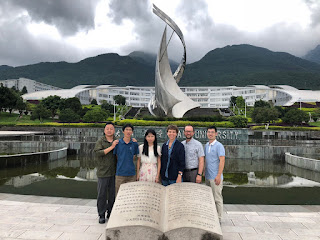 We head off to Yunnan with a gang of eight -- Minxia and Sichi and Minxia's mom; Yi and Miao; and the three of us. Two flights with a brief layover in Kunming. Everyone was so excited to go to Dali because it is beautiful and cool at a higher elevation. Turns out YouJun, a professor at Dali University, had done his PhD in the Yu lab and so was really close friends with everyone, and he spent most of our week in Yunnan with us. We stayed in the ancient town, at the south end of Yuer St., and spent a lot of time wandering among the many thousands of tourists, checking out shops, eating over-the-bridge noodles, flower cakes, and any interesting street foods we found.
We head off to Yunnan with a gang of eight -- Minxia and Sichi and Minxia's mom; Yi and Miao; and the three of us. Two flights with a brief layover in Kunming. Everyone was so excited to go to Dali because it is beautiful and cool at a higher elevation. Turns out YouJun, a professor at Dali University, had done his PhD in the Yu lab and so was really close friends with everyone, and he spent most of our week in Yunnan with us. We stayed in the ancient town, at the south end of Yuer St., and spent a lot of time wandering among the many thousands of tourists, checking out shops, eating over-the-bridge noodles, flower cakes, and any interesting street foods we found. 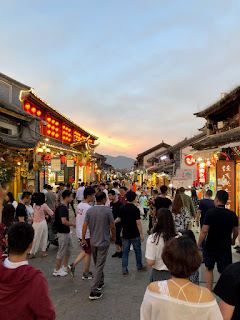 Eli and I have been keeping track of the westerners we've seen since arriving in China. We are now up to 7, including our time in Shanghai and Guangzhou. Even surrounded by many thousands of tourists, there are remarkably few non-Chinese.
Eli and I have been keeping track of the westerners we've seen since arriving in China. We are now up to 7, including our time in Shanghai and Guangzhou. Even surrounded by many thousands of tourists, there are remarkably few non-Chinese. Monday 2 July 2018.
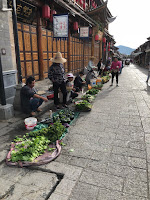 Fun to walk through the ancient Dali city before breakfast while everyone is setting out their vegetables and warm buns and wares for sale. Inspiring seeing groups of older people doing Tai Chi or Square Dancing, sometimes to a disco beat with line dancing.
Fun to walk through the ancient Dali city before breakfast while everyone is setting out their vegetables and warm buns and wares for sale. Inspiring seeing groups of older people doing Tai Chi or Square Dancing, sometimes to a disco beat with line dancing. After breakfast all piled into a rented van and drove all the way around Lake Erhai. We were struck on the drive in from the airport how many large new buildings seems unfinished, and we learned why. The shoreline of Erhai has been developing rapidly in recent years, with lots of largish hotels lining the shoreline. But President Xi visited Dali a while ago and declared it was a jewel that needed to be protected from the influx of pollution and development pressure, so ordered all the lake-shore hotels closed. There they stand, abandoned. From our inquiries, there doesn't seem to be any plan to tear them down, or convert them, just let them stand. We thought they could be readily turned into awesome, green, limnology research centers.
After breakfast all piled into a rented van and drove all the way around Lake Erhai. We were struck on the drive in from the airport how many large new buildings seems unfinished, and we learned why. The shoreline of Erhai has been developing rapidly in recent years, with lots of largish hotels lining the shoreline. But President Xi visited Dali a while ago and declared it was a jewel that needed to be protected from the influx of pollution and development pressure, so ordered all the lake-shore hotels closed. There they stand, abandoned. From our inquiries, there doesn't seem to be any plan to tear them down, or convert them, just let them stand. We thought they could be readily turned into awesome, green, limnology research centers.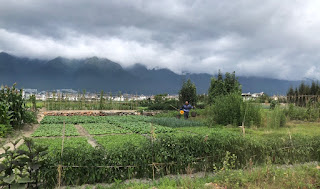
Still, there the land around the lake is extremely fertile -- deep rich black soil, with thriving and diverse agriculture. Our Bai driver said it was nearly all organic.
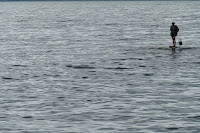 Fishing in the lake is highly restricted to only a month or so each year (although there are plenty of individuals doing personal or small-scale fishing), and swimming is prohibited because of high risk of schistosomiasis. So it is a huge, beautiful lake, completely surrounded by a city of about a million, but with almost no human interaction except scenic beauty.
Fishing in the lake is highly restricted to only a month or so each year (although there are plenty of individuals doing personal or small-scale fishing), and swimming is prohibited because of high risk of schistosomiasis. So it is a huge, beautiful lake, completely surrounded by a city of about a million, but with almost no human interaction except scenic beauty. |
| Bai woman weaving rope from old fishing nets |
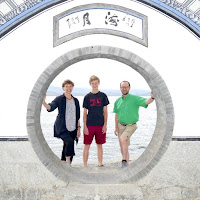 |
| One of the many places set up to take photos, everywhere we went. |
Yunnan is populated not just by the majority Han people, but by a number of minority ethnic groups. Dali has a large population of Bai people, many of whom wear traditional brightly colored clothes, vests, and headwear. I'm not clear about what proportion of the population is Bai, as many do not dress in any distinctive way. They do have a very distinctive language, but they would only converse in Mandarin with our friends, since they did not speak Bai.

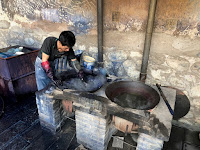 This trip around the lake included a stop at the heart of tie-dying. Spectacular vegetable-died cloths, mostly a rich blue. We got to give it a try with simple versions.
This trip around the lake included a stop at the heart of tie-dying. Spectacular vegetable-died cloths, mostly a rich blue. We got to give it a try with simple versions.Tuesday 3 July 2018.
Visited Dali University today, where YouJun is professor. Because too few of the professors and students there spoke English, they decided that Grad Student Yi Zheng would represent the group in giving a talk. He talked about a project that Ingrid and I are collaborators in, so it was really useful for us to see what the questions were and think more about how the story can come together. Dali University is on top of a really steep hill, and we took a taxi there from our hotel. But the guards wouldn't let the taxi in, and we all had to run up hundreds of steps (already at 9,0000 feet) to get to the conference room (almost) on time for the talk. Poor Yi!
The university is fairly new and rapidly growing, and architecturally very impressive. they have a great museum of natural history -- beautifully and informatively displayed, from fungi to plants to mammals to fish to geology. The faculty collaborated to make a super video about the three-parallel rivers region, starting with the geologic development of the Himalayan mountains and on the ecology of the regions. Really well done. Great screen-based displays about research at the university, and a hallway of photos with spectacular natural history on one side and environmental destruction on the other. They have a very strong emphasis on conservation science.
Wednesday 4 July 2018.
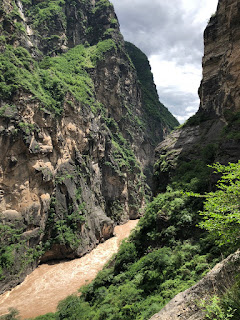 Took a 2-day trip a bit further north to Lijiang. From there we got a serious 10-km workout today at the Tiger Leaping Gorge over the Jinsha tributary to the Yangtze with Yi and Miao. It was a long climb down, and a long climb up (including a really, really long ladder), with a roaring river the whole time. What an amazing and exhausting trip. The pictures speak for themselves.
Took a 2-day trip a bit further north to Lijiang. From there we got a serious 10-km workout today at the Tiger Leaping Gorge over the Jinsha tributary to the Yangtze with Yi and Miao. It was a long climb down, and a long climb up (including a really, really long ladder), with a roaring river the whole time. What an amazing and exhausting trip. The pictures speak for themselves.
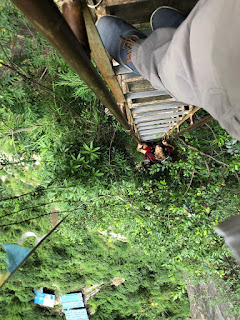 This ladder went on, and on, and on.
This ladder went on, and on, and on. Thursday 5 July 2018.
Another great day in the mountains, this time taking the Cangshan Mountain Cable car up to 3900m just above Dali, where they have installed a very long series of boardwalk to allow ready access with minimal damage through the spruce-rhododendron forest. Some 50 species of rhododendrons (just past peak flowering) and tremendous diversity of other flowering plants (we took photos of dozens of species), while climbing up and down hundreds of steps in steep, cloud covered mountains with little oxygen. A botanists paradise!
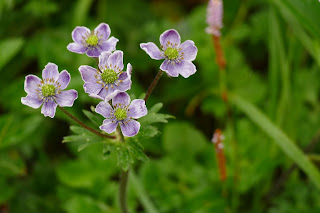

 |
| Glacier-carved Wash Horse Lake |
After a wonderful three weeks, back to Guangzhou for a few more research meetings, then 30+ hours of traveling to Gamboa, Panama for a short 3-week field season.
Wow. What a trip.















